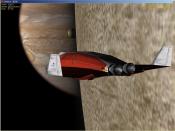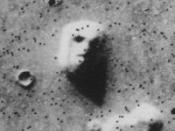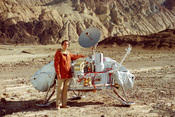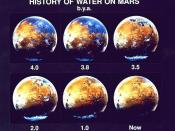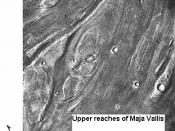Have you ever wondered if we have neighbors that live million light years away? Is the "Sun" for us just a tiny star for them? Do you think that God only made life on this small planet? People through out the ages were seeking answers to these questions. The ancient man as well as the modern man wondered about the stars, about their beauty and function in the universe. On one hand, the church has had question-marks related to this issue. On the other and day after day, scientists and astrologers are discovering new planets, solar systems, and even galaxies, where man can't even reach. I, myself, have always been puzzled by the above questions until I made a simple reasoning: If God created the universe, He must have had a reason for making it infinite and mysterious. However, to claim that he created life only on our small planet, the earth, which is a small drop in this great universe, and that he created the whole universe for man only and made it so vast and mysterious is an over simplification.
This is why I think that life must exist on other planets, and Science supports my claim. Even from the religious point of view, some religious people believe that we're not alone in this universe. So to prove my argument, I will refer to some scientific and religious evidence, keeping in mind that those who believe that life exists only on planet Earth have their own reasons to believe so.
Richard Hoover (n.d.) at NASA's Marshall Space Flight Center and an X-ray astronomer believes that "It's possible to say that ancient impacts of asteroids on the Earth could have ejected soil, rocks, and seawater containing terrestrial microorganisms into space, and that they may have made it to other places in the solar system." (qtd. Dooling, 1998, online). If these microorganisms really made it through space, which I believe they could, then it will only be a matter of searching for them to prove they exist. However, first we should prove that microorganisms, of any kind, could really live in outer space. Hoover believes that microorganisms can survive in ice in outer space for a long period of time (qtd. Dooling, 1998, online). This theory could be proven right by the fact that any bacteria could stop functioning but stay unharmed at low temperatures under 0ðC. Based on the fact that Europa, Jupiter's larger moon, has an icy surface, there's a great possibility that some kind of microorganism could be found alive up there. Moreover, the new images and data that NASA presented about slush and maybe liquid water near the surface of Europa increase the possibility of finding life on it (Dooling, 1998, online). It is no secret that water is the source of life and that it is the right place for hundreds of bacteria and microorganism to live and multiply. Ice is water in a solid state. Therefore, ice could be an environment for some bacteria and microorganism to mature or to become stabilized. Thus the fact that where ever there is water there is life may mean that wherever there is ice there is life. "The overarching theme of NASA's current Mars exploration is 'follow the water' because where there is water, there might possibly be life," (National Geographic, Jan., 2004, p. 8).
For quite sometime it has been the mission of scientists to prove that life may exist in hostile environments. And Indeed, "Discoveries on the Earth over the last few years show that life thrives or can be preserved in a range of "hostile" conditions," Dooling continues, "from volcanic vents deep in ocean trenches, to ice more than 400,000 years old, to Siberian permafrost more than 5 million years old" (1998, online). We are, step by step, by the help of our Earth, reaching the point of proving that life may exist on Europa. Ancient ice had been examined by Hoover and Dr. S. S. Abyzov of Russia's Institute of Microbiology of the Russian Academy of Science in Moscow. The ice is drilled at Russia's Vostok Station about 1,000 Km from the South Pole, from the depth of 386 meters and reached about 3,710 meters, where Lake Vostok was discovered. Liquid water lies beneath the ice for about 100 meters deep. This lake holds clues concerning life on Earth, as it is also a good model for similar conditions on Europa (Dooling, 1998, online). It seems that life in hostile environments on Earth will lead us to the discovery of life on other planets. The ice of the Antarctica will give us the proof ; Dooling confirms that the conditions in Antarctica are like of the conditions in comets, the Martian ice caps, and other icy moons orbiting Jupiter and Saturn; and studying Antarctica deeply is the only and best solution (1998, online). Moreover, Abyzov wrote in a paper that a recent research proved that microorganisms may survive in anabiotic states at high altitude in interplanetary space in tremendously sever atmospheres of cosmic environments (qtd. Dooling, 1998, online). Since it is now proven that microorganisms may survive in outer space, we only need know hard evidence from the ice of Europa that will once and for all prove us right.
As more and more space discoveries are appearing, scientists are finding out more about the present Mars and the ancient one. Assumptions about the ancient Mars states that it was covered with ice, 50,000 to 500,000 years ago, as Phil Christensen, geologist, Arizona State University, mentioned, "If you'd viewed Mars then, you would have called it the white planet," (National Geographic, Jan., 2004, p. 7). And if there were ice on Mars so definitely water lies under it. And as I mentioned earlier, where water is found, life would be more possible to occur. Spirit and Opportunity, the Mars rovers, had persuaded Mars experts that water occurred on Mars' surface in the late past (Overbye, 2006, p. F.1). Sometime before that time and specifically during the 1970's, Mariner 9 and the two Viking missions changed the way that scientists used to see Mars. Pictures showed volcanoes double the size of those on Earth, canyons as deep as the Earth's deepest ocean trenches, dry river systems, and plains scoured by floods that can deplete the Mediterranean in a month (National Geographic, Jan., 2004, p. 14). All of the above mentioned, are evidence that liquids were floating on Mars' surface a long time ago; and what is most logical is the fact that this liquid is water, since water ice was covering what is called "The Red Planet" today.
Pictures from these orbiters [Mariner 9 and the tow Viking missions] introduced another new mars: one that was not just a dead rock but rather a fossil. In the planet's youth, scientists had theorized, the atmosphere was thick, the greenhouse effect strong, and water flowed through the valleys. But the greenhouse had been temporary; the atmosphere thinned, and the planet cooled. Except for the scraps frozen into the polar caps, its water was lost to space or stored away as subsurface ice. And this all happened billions of years ago. The early Mars had been dynamic; the Viking Mars was more or less inert and-as the Viking landers showed us-lifeless. (National Geographic, Jan., 2004, pp. 14,15).
It is clear that Mars have been witnessing many changes, and all evidence till now shows that Mars was covered with snow. The only thing left is to prove that water exists or existed on Mars. Infrared readings indicated that the landing site of Opportunity in Terra Meridiani, on Mars, showed traces of a mineral hematite that is naturally created in the presence of water, and this site turned to be, in addition to Gusev, the safest and smoothest landing site in Mars; furthermore, evidence could be found at that site for minerals associated with water (National Geographic, Jan., 2004, p. 28). Mars is now becoming clearer to the scientist, where they are capable of going to the depth of this issue, and discover new things day after day that will step us forward in discovering life on Mars. "Today mars looks a lot like a globe of ice than ever has before. But it also looks like something shucking that ice away, something moving on, something undergoing change. Whatever else Mars turns out to be, it won't be useless, changeless lump in the universe," (National Geographic, Jan., 2004, p. 30). Although, hard evidence that supports the above view is not yet available, but one should expect the unexpected, and the recent discoveries have made scientists closer than ever to prove their point. Still if science cannot now give us definite answers, then maybe religions and religious people can give us some clues.
Religions have an opinion about life in the universe. The cosmologies of the Hindus and Buddhists are loaded with other universes occupied by celestial beings (Woodward, 1996, p.58). We all know that Hinduism and Buddhism are of the oldest and deepest religions on earth, and it is very important to know that a whole religion believes in the presence of extraterrestrials living on other planets. Even for some Christians, life on other planets may occur. "As a theologian, I would say that this proposed searchâ¦is also one of knowing and understanding God through his works. Finding others than ourselves would mean knowing him better," said Holy Cross Fr. Theodore Hesburgh (n.d.), emeritus president of the University of Notre Dame (qtd. Heffern, 2006, p. 12, 13). The existence of celestial life will enhance our beliefs and not weaken them, we could see God from other point of view; we will see how enormous God is in his creations. Jesuit Guy Consulmagno (n.d.), a specialist on meteorites said that "finding life on other planets is a vindication that God is not limited by our imagination, as our understanding of creation grows, our understanding of God gets bigger," (qtd. Woodward, 1996, p.58). We can't bound God's creations to our imaginations, because our imagination is so limited, and God is unlimited, he is found everywhere in the universe. Consulmagno (n.d) also added, "it may be that God became incarnate in other forms elsewhere in the universe, if we were to make contact with other intelligent life, we'd have to tell our own sacred story, listen to them tell theirs, and learn," (qtd. Woodward, 1996, p.58). It is definitely crucial to listen and learn about their God and compare it with our God that we know and believe in. Jesuit Fr. George Coyne (n.d.), former director of the Vatican Observatory believes that the discovery of extraterrestrial life sovereign from the origins of life on earth, would be historic, and the existence of two independent origins would signify that life is inexhaustible, and that will spectacularly change our view of ourselves and of God (qtd. Heffern, 2006, p. 12,13).
To David Slavsky (n.d.), dean of science and mathematics at Loyola University in Chicago and a religious Jew, the possibility of extraterrestrial intelligence opens up a new sense of community, "and an expanded notion of sacred drama"; our sense of society changed from that of 5,000 years ago, where it is now, everyone on earth is part of one community. Slavsky hopes that this sense, one day, would expand to a community of the universe (qtd. Woodward, 1996, p.58). God's abilities and power is beyond our expectations and imaginations, and that's the secret of life which we all seek to find out and understand, but unfortunately, nobody can, hope with the help of our neighbors we could at least be one step ahead and understand God in a deeper way.
However, some religious people believe that we are unique in the universe, and we are in the image of God, and there is no way that extraterrestrial life can be found. Paul Davies (2003) said that "Just contemplating the possibility of such advanced extraterrestrials appears to raise additional uncomfortable questions for religion" (pp, 112-117). Furthermore, "God created man in his image; in the divine image he created him; male and female he created them," (Genesis1, 27). In the Holy Bible, everything was about us and how we are unique than other creatures on earth, about life on earth, how god created the universe, and every single detail about the creation of life on earth. However, Astronomer Owen Gingerich, a conservative Protestant, explains that "in Genesis there's a sacred story being told that focuses on us. But there is nothing that precludes intelligent life elsewhere in the universe. It would be extremely arrogant to limit God's creativity to human beings as the only contemplative creatures in the universe," (qtd. Woodward, 1996, p, 58). So if we don't know or have proof that extraterrestrials really don't exist, then we can't judge God's creativity, that's really not our job. "Our imagination is always going to be inadequate to divine reality. My own work in cosmology indicates there are possibly trillions of other universes besides ours. We're finding hard evidence that God is far above our and beyond anything we can image, in ways that go beyond what people of earlier centuries ever imagined God to be," said Stoeger (n.d.), (qtd. Heffern, 2006, pp, 12, 13). We are in a solar system which is found in a galaxy, that is formed of billions of stars and other solar systems, that is found in a universe that is formed of billions of galaxies, so if you even try to count them all it would take a life time to get the correct and exact number which is near infinity, so do you think that God created all of this just to watch and enjoy, or God was bored and started having fun by creating new stars, planets and galaxies. It is definitely made for a reason, and the most logical one is that life on other planets exists. Heffern (2006) claims that "sorting through billions on billions of stars is as formidable as looking for a needle among all the grains of sand on all the world's beaches" (pp, 12, 13). That is really impossible in both ways, however why don't we try what we can do and maybe we'll do it right.
As a conclusion, I must say that although there is no hard evidence that life on other planets is found, there is a high possibility of finding it. Many say that we don't have any single clue that life really exists in another place in the universe, like Democrat Sen. William Proxmire (n.d.) said that "there isn't a scintilla of evidence that intelligent life exists beyond our solar system"; then a scientist replied that "as late as 1491 there wasn't a scintilla of evidence that America existed," (qtd. Heffern, 2006, pp. 12, 13). As America was discovered by chance, maybe we will discover and find our celestial neighbors somewhere, sometime, and by chance. And as I said earlier, we must expect the unexpected and be prepared to deal with it. One may even ask other related questions: Are extraterrestrials really visiting earth? Are they watching us without us knowing about them? And is the Roswell UFO crash in 1947 just a lie or is it a myth? It seems that now, the only thing left is to wait for highly developed researches that may give us, once and for all, all the evidence that we need to prove that life on other planets really occur. This is why I fully agree with Carl Sagan who, just before he died, described the universe he had discovered from a lifetime's work in astronomy: "There is a place with four suns in the sky - red, white, blue and yellow; two of them are so close together they touch, and star-stuff flows between them. I know of a world with a million moons. I know of a sun the size of Earth - and made of diamond. â¦. The universe is vast and awesome, and for the first time we are becoming part of it," (qtd. Heffern, 2006, pp. 12, 13).
ReferencesDooling, D. (March 5, 1998). Clues to possible life on Europa may lie buried in Antarctic ice. NASA webpage. Retrieved on 1/20/2007. Available at http://science.msfc.nasa.gov/newhome/headlines/ast05mar98_1.htmGenesis1 (1991). The new American Bible. Iowa Falls: World Bible Publishers, Inc. pp. 8-9.
Heffern, R. (Oct. 20, 2006). Looking for company beyond the skies. National Catholic Reporter. Vol. 43. No. 1. pp. 12-13.
Is there life in the ancient ice? (Jan. 2004). National Geographic. pp. 7-31.
Overbye, D. (Dec. 12, 2006). Bake to the Moon! But Why? The New York Times. Retrieved on 1/9/2007. Available at http://proquest.umi.com/pqdweb?index=6&sid=1&srchmode=1&vinst=PROD&fmt=3âÂÂ...
Woodward, K. (Aug. 19, 1996). A vindication of God. Newsweek. Vol. 128. No. 8. p. 58.
